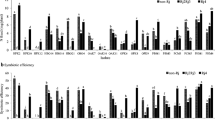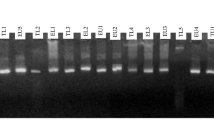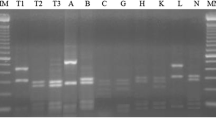Abstract
While soybean is an exotic crop introduced in Kenya early last century, promiscuous (TGx) varieties which nodulate with indigenous rhizobia have only recently been introduced. Since farmers in Kenya generally cannot afford or access fertilizer or inoculants, the identification of effective indigenous Bradyrhizobium strains which nodulate promiscuous soybean could be useful in the development of inoculant strains. Genetic diversity and phylogeny of indigenous Bradyrhizobium strains nodulating seven introduced promiscuous soybean varieties grown in two different sites in Kenya was assayed using the Polymerase Chain Reaction-Restriction Fragment Length Polymorphism (PCR-RFLP) of the 16S-23S rDNA intergenic spacer region and 16S rRNA gene sequencing. PCR-RFLP analysis directly applied on 289 nodules using Msp I distinguished 18 intergenic spacer groups (IGS) I–XVIII. Predominant IGS groups were I, III, II, IV and VI which constituted 43.9%, 24.6%, 8.3% 7.6% and 6.9% respectively of all the analyzed nodules from the two sites while IGS group VII, IX, X, XI, XII, XIV, XVI, XVII, XVIII each constituted 1% or less. The IGS groups were specific to sites and treatments but not varieties. Phylogenetic analysis of the 16S rRNA gene sequences showed that all indigenous strains belong to the genus Bradyrhizobium. Bradyrhizobium elkanii, Bradyrhizobium spp and Bradyrhizobium japonicum related strains were the most predominant and accounted for 37.9%, 34.5%, and 20.7% respectively while B. yuanmigense related accounted for 6.9% of all strains identified in the two combined sites. The diversity identified in Bradyrhizobium populations in the two sites represent a valuable genetic resource that has potential utility for the selection of more competitive and effective strains to improve biological nitrogen fixation and thus increase soybean yields at low cost.


Similar content being viewed by others
References
Abaidoo RC, Keyser HH, Singleton PW, Borthakur D (2000) Bradyrhizobia spp (TGx) isolates nodulating the new soybean cultivars in Africa are diverse and distinct from bradyrhizobia that nodulate North American soybeans. Int J Syst Evol Microbiol 50:225–234
Abaidoo RC, Keyser HH, Singleton PW, Borthakur D (2002) Comparison of molecular and antibiotic resistance profile method for the population analysis of bradyrhizobia spp (TGx) isolates that nodulate the new TGx soybean cultivars in Africa. J Appl Microbiol 92:109–117
Abaidoo RC, Keyser HH, Singleton PW, Dashiell KE, Sanginga N (2007) Population size, distribution, and symbiotic characteristics of indigenous Bradyrhizobium spp. that nodulate TGx soybean genotypes in Africa. Appl Soil Ecol 35:57–67
Andrade DS, Murthy PJ, Giller KE (2002) The diversity of Phaseolus -nodulating rhizobial populations is altered by liming of acid soils planted with Phaseolus vulgaris L. in Brazil. Appl Environ Microbiol 68(8):4025–4034
Anyango B, Wilson KJ, Beynon JL, Giller KE (1995) Diversity of rhizobia nodulating P. vulgaris L. in two Kenya soils with contrasting pH. Appl Environ Microbiol 61:4016–4021
Ayanaba A (1977) Toward a better use of inoculants in the humid tropics. In: Ayanaba A, Dart PJ (eds) Biological nitrogen fixation in farming systems of the tropics. Wiley, New York, pp 181–187
Batista JSS, Hungria M, Barcellos FG, Ferreira MC, Mendes IC (2006) Variability in Bradyrhizobium japonicum and B. elkanii seven years after introduction of both the exotic microsymbiont and the soybean host in the Cerrados soil. Microbiol Ecol 53:270–284
Brockwell J, Pilka A, Halliday RA (1991) Soil pH is a major determinant of the numbers of naturally occurring Rhizobium meliloti, in non cultivated soils of New South Wales. Aust J Exp Agric 31:211–219
Caldwel BE, Vest GE (1968) Effects of Rhizobium japonicum on soybean. Crop Sci 10:19–21
Chen W, Qiaoyun H, Xiaojiao X (2004) Distribution and biodiversity of soybean rhizobia in the soils of Shennongjia forest reserve, China. Biol Fert Soil 40(5):306–312
Doignon-Bourcier F, Willems A, Coopman R, Laguerre G, Gillis M, de Lajudie P (2000) Genotypic characterization of Bradyrhizobium strains nodulating small Senegalese legumes by 16S-23S rRNA intergenic gene spacers and amplified fragment length polymorphism fingerprint analyses. Appl Environ Microbiol 66:3987–3997
FAO UNESCO (1990) FAO UNESCO soil map of the world 1:5,000,000 Vol VI Africa. UNESCO, Paris
Fehr WR, Caviness CE, Burmood DT, Penington JS (1971) Stage of development descriptions of soybean Glycine max (L) Merr. Crop Sc 11:929–931
Felsestein J (1993) Phylogenetic. Inference package version 3.5c. Department of Genetics University of Washington
Giongo A, Ambrosini A, Vargas LK, Freire JRJ, Bodanese-Zanettini MH, Passaglia LMP (2008) Evaluation of genetic diversity of bradyrhizobia strains nodulating soybean [Glycine max (L.) Merrill] isolated from South Brazilian fields. Appl Soil Ecol 38(3):261–269
Graham PH, Sadowsky MJ, Keyser HH, Barnet YM, Bradley RS, Cooper JE, De Ley DJ, Jarvis BDW, Roslycky EB, Strijdom BW, Young JPW (1991) Proposed minimum standards for the description of new genera and species of root-and stem-nodulationg bacteria. Int J Syst Bacteriol 41:582–587
GTZ (1996) Kenya soybean cook book. Ministry of Agriculture and Livestock Development and Marketing, Nairobi
Gunawardena SFBN, Danso SKA, Zapata F (1993) Phosphorus requirement and success of nitrogen in three soybean (Glycine max) genotypes, Bragg, nts 382 and Chippewa. Plant Soil 151:1–9
Hulton CSJ, Higgins CF, Sharp PM (1991) ERIC sequences: A novel family of repetitive elements in the genomes of Escherichia coli, Salmonella typhimurium and other Enterobacteriaceae. Mol Microbiol 5:825–834
Hungria M, Campo RJ, Chueire LM, Youssef L, Agustin P, Guttierrez-Mañero FJ, Rubens JC (2006) Genetic diversity of indigenous tropical fast-growing rhizobia isolated from soybean nodules. Plant Soil 288:343–356
ICRAF laboratory methods for soil and plant analysis, May 1999.
Kahindi JHP, Woomer P, George T, de Souza Moreira FM, Karanja NK, Giller KE (1997) Agricultural intensification soil biodiversity and ecosystem function in the tropics: the role of nitrogen fixing bacteria. Appl Soil Ecol 6:55–76
Kasasa P (1999) Biological nitrogen fixation by promiscuous nodulating soybean (Glycine max [L] Merr) varieties in the communal soils of Zimbabwe. M. Phil Thesis University of Zimbabwe, Harare, pp 118
King LM, Schaal BA (1989) Ribosomal DNA variation and distribution in Rudbeckia missouriensis. Evol l42:1117–1119
Krasova-Wade T, Ndoye I, Braconnier S, Sarr B, de Lajuide P, Neyra M (2003) Diversity of indigenous bradyrhizobia associated with three cowpea cultivars (Vigna unguiculata L.) (Walp.) grown under limited and favorable water conditions in Senegal (West Africa). Afr J Bacteriol 2(1):13–22
Kueneman EA, Root WR, Dashiell KE, Hohenberg J (1984) Breeding soyabean for the tropics capable of nodulating effectively with indigenous Rhizobium spp. Plant Soil 82:387–396
Laguerre G, Allard M, Revoy R, Amager N (1994) Rapid identification of rhizobia by restriction length polymorphism analysis of PCR amplified 16S rRNA genes. Appl Environ Microbiol 60:56–63
Lane DJ (1991) 16S-23S rRNA sequencing. In: Stackebrandt E, Goodfellow M (eds) Nucleic acid techniques in bacterial systematics. Wiley, London, pp 115–175
Lanham PG, Brennan RM (1999) Genetic characterization of gooseberry Ribes grossularia subgenus grossularia germplasm using RAPD, ISSR and ALFP markers. Hort Sci Biotech J 74:361–366
Mpepereki S, Javaheri F, Davis P, Giller KE (2000) Soybean and Sustainable Agriculture: Promiscuous soyabeans in Southern Africa. Field Crop Res 65:137–149
Mullen DM, Israel DW, Wollum AG (1988) Effects of Bradyrhizobium japonicum and soybean (Glycine max (L) Merr.) on phosphorus nutrition, nodulation and nitrogen fixation. Appl Environ Microbiol 54:2387–2392
Mulongoy K, Ayanaba A (1986) Dynamics of population sizes of cowpea and soybean rhizobia at three locations in West Africa. Mircen J 2:301–308
Munns DN, Hohenberg JS, Righetti TL, Lauter DJ (1981) Soil acidity tolerance of symbiotic and nitrogen-fertilized Soybean. Agron J 73:407–410
Musiyiwa K, Mpepereki S, Giller KE (2005) Physiological diversity of rhizobia nodulating promiscuous soyabean in Zimbabwean soils. Symbiosis 40:97–107
Nakamura Y, Leppert M, O’Connell P, Wolff R, Holm T, Culver M, Martin C, Fujimoto E, Hoff M, Kumlin E, White R (1987) Variable number tandem repeat (VNTR) markers for human gene mapping. Sci 235:1616–1622
Navarro E, Simonet P, Normand P, Bardin R (1992) Characterization of natural population of Nitrobacter spp using PCR-RFLP analysis of ribosomal intergenic spacer. Arch Microbiol 157:107–115
Njuguna SK (1985) Potential of soybeans in fulfilling Kenya’s protein and oil requirements. Proc. of American Soybean Association Conference. ILRAD, Kenya
Odee DW, Haukka K, McInroy SG, Sprent JI, Sutherland JM, Young JPW (2002) Genetic and symbiotic characterization of rhizobia isolated from tree and herbaceous legumes grown in soils from ecologically diverse sites in Kenya. Soil Biol Biochem 34:804–811
Okereke GU, Eaglesham ARJ (1992) Nodulation and Nitrogen fixation by 79 “promiscuous” soybean genotypes in a soil in east Nigeria. Agron Afr V 2:23–136
Padzemik DL, Vance CP, Sadowsky MJ, Graham PH, Orf JH (1977) A host controlled sero group-specific, infective nodulation system in the Bradyrhizobium-soybean (Glycine max) symbiosis. Mol Plant-Microbe Interactions 10:994–1001
Ponsonnet C, Nesme X (1994) Identification of agrobacterium strains by PCR-RFLP analysis of pTi and chromosomal regions. Arch Microbiol 161:300–309
Pueppke SG, Broughton WJ (1999) Rhizobium sp strain NGR 234 and R. freidii USDA 257 share exceptionally broad nested host ranges. Mol Plant-Microbe Interactions 10:994–1001
Rouvier C, Prin Y, Reddel P, Normand P, Simonet P (1996) Genetic diversity among Frankia strains nodulating members of the family Casuarinaceae in Australia revealed by PCR and restriction fragment length polymorphism analysis with crushed root nodules. Appl Environ Microbiol 62:979–985
Sanginga N, Abaidoo RC, Dashiel K, Carsky RJ, Okogun AJ (1996) Persistence and effectiveness of rhizobia nodulating promiscuous soybean in moist savanna zones of Nigeria. Appl Soil Ecol 3:215–224
Sanginga N, Thottappilly G, Dashiel K (2000) Effectiveness of rhizobia nodulating recent promiscuous soybean selections in the moist savanna of Nigeria. Soil Biol Biochem 32:127–133
Sarr A, Neyra M, Abdeljalil M, Houeibib O, Ndoye I, Oihabi A, Lesueur D (2005) Rhizobial populations in soils from natural Acacia senegal and Acacia nilotica forests in Mauritania and the Senegal River Valley. Microbiol Ecol 50:152–162
Saitou RR, Nei M (1987) A neighbor-joining method: a new method for reconstructing phylogenetic trees. Mol Biol Evol 44:406–425
Sikora S, Redzepovic S (2003) Genotypic characterization of indigenous soybean rhizobia by PCR-RFLP of 16S rDNA, rep-PCR and RAPD analysis. Food Tech Biotech 41(1):61–67
Sinclair TR, Valdez V (2002) Physiological traits for crop yield improvement in low N and P environments. Plant Soil 245:1–15
Somasegaran P, Hoben HJ (1994) Handbook for rhizobia: Methods in legume-Rhizobium Technology. Springer-Verlag, New York
Stern MJ, Ferro-Luzzi Amess G, Smith NH, Robinson EC, Higgins CF (1984) Repetitive extragenic palindromic sequences: A major component of the bacterial genome. Cell 37:1015–1026
Thiao M, Neyra M, Isidore E, Sylla S, Lesueur D (2004) Diversity and effectiveness of rhizobium from Gliricidia sepium native to Reunion Island, Kenya and New Caledonia. World J Microbiol Biotech 20:703–709
Thies JE, Singleton PW, Bohlool BB (1991a) Influence of the size of indigenous rhizobial populations on the establishment and symbiotic performance of introduced rhizobia on field-grown legumes. Appl Environ Microbiol 57:19–28
Thompson JD, Gibson TJ, Plewniak F, Jeanmougin F, Higgins DG (1997) The CLUSTAL X windows interface: flexible strategies for multiple sequence alignment aided by quality analysis tools. Nucleic Acid Res 25:4876–4882
TSBF (2003) The Comminutor Newsletter of the TSBF Institute of CIAT, Vol 7 No.1 pp 15–16
Turk D, Keyser HH, Singleton PW (1993) Response of tree legume to rhizobial inoculation in relation to the population density of indigenous rhizobia. Soil Biol Biochem 25:75–81
Vinuesa P, Rademaker JLW, de Brujin FJ, Werner D (1998) Genotypic characterization of Bradyrhizobium strains nodulating endemic woody legumes of the Canary Islands by PCR-Restriction Length Polymorphism analysis of genes encoding 16S rDNA and 16S-23S rDNA Intergenic Spacers, Repetitive Extragenic Palindromic PCR genomic fingerprinting, and partial 16S r RNA sequencing. Appl Environ Microbiol 64:2096–2104
Virdi JS, Sachdeva P (2005) Genetic diversity of pathogenic microorganisms: Basic in sights, public health implications and the Indian initiatives. Current Sci 89(1):113–123
Vos P, Hogers R, Bleeker M, Reijans M, van de Lee T, Hornes M, Fritjers A, Pot J, Peleman J, Kuiper M, Zabeau M (1995) AFLP: A new concept for DNA fingerprinting. Nucleic Acid Res 23:4407–4414
Wei TZ, Yang JK, Yuan TY, Zhou JC (2007) Genetic diversity and phylogeny of indigenous rhizobia from cowpea [Vigna unguiculata (L) Walp]. Biol Fert Soils 44:201–210
Williams GK, Kubelik AR, Livak KJ, Rafalski JA, Tingey SV (1990) DNA polymorphisms amplified by arbitrary primers are useful as genetic markers. Nucleic Acid Res 18:6531–6535
Xu LM, Ge C, Cui Z, Li J, Fan H (1995) Bradyrhizobium liaoningense sp nov., isolated from root nodules of soybeans. Int J Syst Bacteriol 45:706–711
Zahran HH (1999) Rhizobium-legume symbiosis and nitrogen fixation under severe conditions and in an arid climate. Microbiol Mol Rev 63:968–989
Acknowledgement
This research was funded by the Rockefeller Foundation Project: “Exploring the multiple potentials of soybeans in enhancing rural livelihoods and small industry in east Africa” through Tropical Soil Biology and Fertility of International Centre for Tropical Agriculture (TSBF-CIAT) and Kenya Agricultural Productivity Project and both are gratefully acknowledged.
Author information
Authors and Affiliations
Corresponding author
Additional information
Responsible Editor: Euan K. James.
Rights and permissions
About this article
Cite this article
Wasike, V.W., Lesueur, D., Wachira, F.N. et al. Genetic diversity of indigenous Bradyrhizobium nodulating promiscuous soybean [Glycine max (L) Merr.] varieties in Kenya: Impact of phosphorus and lime fertilization in two contrasting sites. Plant Soil 322, 151–163 (2009). https://doi.org/10.1007/s11104-009-9902-7
Received:
Accepted:
Published:
Issue Date:
DOI: https://doi.org/10.1007/s11104-009-9902-7




